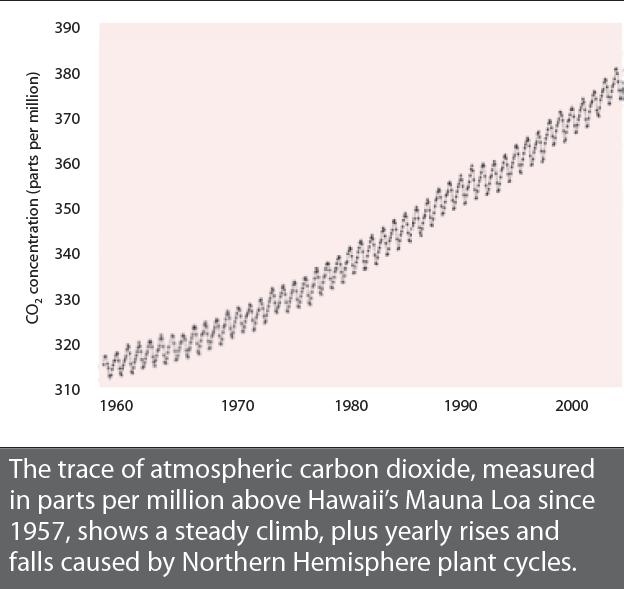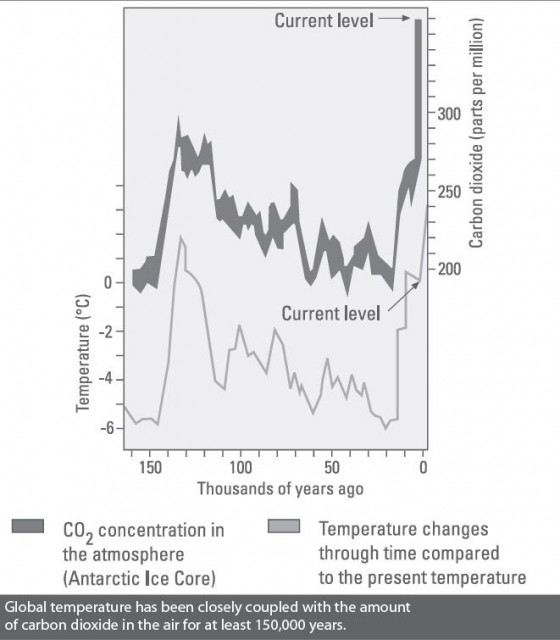The basics
One of the most deceiving aspects of climate change is the aura of controversy surrounding it. In the US, in particular, many journalists have tended to portray global wanning as an either/or proposition: either it's warming or its not, either were to blame or we aren't, either we know what's going to happen or we don't. By setting up these two-sided battles, the media granted disproportionate visibility to a small group of global-change “naysayers” (who are by no means a unified body) and to industries that have an understandable stake in the status quo.
On the other side of this artificial divide are the vast majority of those scientists who gather climate data, sift through it for trends, and use computer models to simulate the atmosphere's future. Like the naysayers, these researchers are far from a unified group. However, they are in clear agreement on many aspects of the problem. There's no better proof of this than the reports of the Intergovernmental Panel on Climate Change (IPCC). Since 1988, the United Nations has sponsored this loose-knit body, which includes many hundreds of climate change scientists drawn from universities and laboratories worldwide. Every few years, the IPCC issues a comprehensive set of reports designed to help governments and other planners approach the questions posed by climate change. The first summary of its fourth major assessment was released in February 2007.
Some of the key points put forth in recent climate analyses:
- The world's surface air temperature has warmed by close to 0.8°C/1.44°F since the late 1800s. The figure is based on measurements from weather stations on land and from the 70 percent of Earth covered by ocean. For climate purposes, air temperature over the sea is usually estimated from water temperature; this tends to smooth out the short-term wiggles but retain the longer trends. Some places, like the Arctic, have warmed more than the average. Others have warmed less or even cooled slightly, such as the southeastern US. Satellites have inferred temperatures several miles up since the late 1970s. For years they showed less warming aloft than at the surface, but that difference has now been explained by instrument quirks and other factors.
- Beyond the temperature record, there is concrete evidence of warming In the world around us. Summer sea ice in the Arctic is barely half as thick as It was in 1950. Mountain glaciers around the globe have receded notably. Sea level has risen about 10-20cm/4-8in since 1900: most of this is due to sheer expansion of the warmed-up oceans rather than melted ice from glaciers. About a quarter of the world's coral reefs have been seriously damaged or destroyed in the last several decades, with rising ocean temperatures considered to be one of the main factors at work. The oceans themselves are also changing: as they absorb increasing amounts of carbon dioxide (C02) from the atmosphere, this makes the seawater less alkaline, posing a serious threat to many marine ecosystems.
- Industrial emissions of greenhouses gases – most importantly, CO2 – are almost certainly to blame for a good part of the past century's temperature increase. In 2007, the IPCC concluded that “most of the observed increase in globally averaged temperatures since the mid-20th century is very likely due to the observed increase in anthropogenic greenhouse gas concentrations, few naysayers continue to argue that the twentieth-century warming may have occurred as a result of solar influences or other factors. We'll take a closer look at these arguments below.
- Temperatures will continue to go up. In 1990, and again in 1995, the IPCC projected that the global average might increase by about 1.5-4.5°C/7-8.0°F by the year 2100. In 2001 they expanded that range to 1.4-5.8°C/2.5-10.4®F. A follow-up study by IPCC scientists Tom Wig ley and Sarah Raper projected a 50/50 chance that readings will fall near the centre of this range, or around 2.5-4°C/4-7°F.The 2007 IPCC projections changed little, with the best estimates of 21st-century warming at 1.8-4.0°C/3.2-7.2°F. The range reflects uncertainty in how much emissions will be controlled. These projections are drawn from computer models that have received their share of criticism. Imperfect and simplified as they are, these models are the only real tools at hand for gauging when and how global changes might become manifest Indeed, every modern weather forecast is based on a computer model.

What's going on here?
The greenhouse effect itself is no cause for alarm. It's a natural part of our climate system, one that's been acknowledged for more than a century as something we need in order to survive. By holding in heat that would otherwise escape directly to outer space, greenhouse gases help to create a safe, cosy atmosphere. Without these gases, our average global temperature would be well below freezing. On the other hand, too much of a good thing can be counter-productive. Venus has an atmosphere that's 97 percent carbon dioxide. Coupled with its position closer to the sun, this keeps the Venusian surface atmosphere close to a broiling 460°C/860°F.
Ancient air samples taken from layers of ice in the Arctic and Antarctic reveal that the percentage of carbon dioxide in Earth's atmosphere has varied more or less in accordance with global temperature for over 100,000 years. It's not yet proven whether changes in C02 caused these temperature changes, or vice versa; it appears that changes in either one can prompt a response in the other and trigger a self-reinforcing cascade of effects. Great sheets of ice covered much of present-day Canada and parts of Europe and Asia for more than 80,000 of these last 100,000 years, and C02 at that time was about 30 percent less prevalent in the atmosphere than today. Ice cores and other records indicate that carbon dioxide levels also dropped by several percent during the Little Ice Age, which caused noticeably more severe winters across Europe from the mid-1500s to the mid-1800s. Before industrial emissions began changing things, C02 made up an average of about 0.027-28 percent of the air, or 270-280 parts per million (ppm). This represents only about a hundredth of the world's carbon; much more is locked up in the oceans, in sediments and in fossil fuels that release C02 to the air as they're burned.

In 1895, Sweden's Svante Arrhenius was the first scientist to proclaim that the rise in carbon dioxide from fossil-fiiel emissions would lead to global warming. He calculated that the temperature rise from a doubling of C02 would be around 5°C/9°F – not all that far off from our best modern-day estimates. However, although he didn't think it was likely to happen, Arrhenius postulated that such an increase might be a good thing, resulting in a less harsh environment for future generations. In the 1930s, British
engineer George Callendar linked a 54-year temperature rise at two hundred weather stations around the world to fossil-fuel emissions. Like Arrhenius, he saw this as a beneficial side-effect of industrial growth rather than a worrisome trend.
As an outgrowth of the International Geophysical Year in 1957-58, chemist Charles Keeling began carrying out regular C02 measurements on top of Mauna Loa in Hawaii using a new high-resolution sensor. Checking the data against C02 readings from the South Pole and elsewhere, Keeling and colleagues were able to produce one of the most famous, ominous graphs in science. It shows an inexorable year-by-year rise in atmospheric carbon dioxide. Because the lowest few miles of the atmosphere are so thoroughly mixed, the Hawaii data reflects the state of carbon dioxide everywhere around the globe. The C02 rise is about 0.4 percent a year, from 316 ppm in 1958 to 378 ppm in 2004. As best we can tell, we now have the highest level of global atmospheric C02 in at least the past 600,000 years, and the level continues to rise.
There are other important greenhouse gases besides C02. Methane is an industrial byproduct that's also emitted in surprisingly large amounts by rice paddies and by millions of belching cows. Nitrous oxide is another industrial gas with a powerful greenhouse effect. Even water vapour is a greenhouse gas – in fact, it's the most prevalent one. Although several greenhouse gases are more potent on a molecule-by-molecule basis, there's so much carbon dioxide in the air that it has more overall impact than the other human-produced gases combined. Thus, many studies use C02 as a stand-in for the entire group.